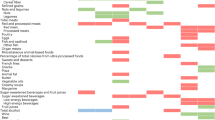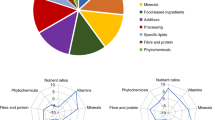Abstract
Background/objectives:
A number of different nutrient-profiling models have been proposed and several applications of nutrient profiling have been identified. This paper outlines the potential role of nutrient-profiling applications in the prevention of diet-related chronic disease (DRCD), and considers the feasibility of a core nutrient-profiling system, which could be modified for purpose, to underpin the multiple potential applications in a particular country.
Methods:
The ‘Four ‘P's of Marketing’ (Product, Promotion, Place and Price) are used as a framework for identifying and for classifying potential applications of nutrient profiling. A logic pathway is then presented that can be used to gauge the potential impact of nutrient-profiling interventions on changes in behaviour, changes in diet and, ultimately, changes in DRCD outcomes. The feasibility of a core nutrient-profiling system is assessed by examining the implications of different model design decisions and their suitability to different purposes.
Results and conclusions:
There is substantial scope to use nutrient profiling as part of the policies for the prevention of DRCD. A core nutrient-profiling system underpinning the various applications is likely to reduce discrepancies and minimise the confusion for regulators, manufacturers and consumers. It seems feasible that common elements, such as a standard scoring method, a core set of nutrients and food components, and defined food categories, could be incorporated as part of a core system, with additional application-specific criteria applying. However, in developing and in implementing such a system, several country-specific contextual and technical factors would need to be balanced.
This is a preview of subscription content, access via your institution
Access options
Subscribe to this journal
Receive 12 print issues and online access
$259.00 per year
only $21.58 per issue
Buy this article
- Purchase on Springer Link
- Instant access to full article PDF
Prices may be subject to local taxes which are calculated during checkout

Similar content being viewed by others
References
Baggett CD, Stevens J, Catellier DJ, Evenson KR, McMurray RG, He K et al. (2010). Compensation or displacement of physical activity in middle-school girls: the Trial of Activity for Adolescent Girls. Int J Obes 34, 1193–1199.
Blundell JE, Stubbs RJ, Hughes DA, Whybrow S, King NA (2003). Cross talk between physical activity and appetite control: does physical activity stimulate appetite? Proc Nutr Soc 62, 651–661.
Carter R, Vos T, Moodie M, Haby M, Magnus A, Mihalopoulos C (2008). Priority setting in health: origins, description and application of the Australian Assessing Cost-Effectiveness initiative. Expert Rev Pharmacoecon Outcomes Res 8, 593–617.
Climate Labelling for Food (2010). Climate Labelling for Food, viewed May 2010, http://www.klimatmarkningen.se/.
Drewnowski A (2010). The nutrient rich foods index helps to identify healthy, affordable foods. Am J Clin Nutr 91, 1095S–1101S.
European Food Safety Authority (2010). Nutrition & health claims, viewed August 2010, http://www.efsa.europa.eu/en/faqs/faqnutrition.htm.
Ezzati M, Lopez A, Rodgers A, Murray C (2004). Comparative Quantification of Health Risks: Global and Regional Burden of Disease Attributable to Selected Major Risk Factors. World Health Organization: Geneva.
Food Standards Agency United Kingdom (2007). Front-of-pack traffic light signpost labelling, Technical guidance, Issue 2, viewed March 2010, http://www.eatwell.gov.uk/foodlabels/trafficlights/.
Food Standards Australia New Zealand (2008). Nutrition, Health and Related Claims, viewed March 2008, http://www.foodstandards.gov.au/foodmatters/healthnutritionandrelatedclaims/index.cfm.
French J, Blair-Stevens C, McVey D, Merritt R (2009). Social Marketing and Public Health. Theory and practice Oxford University Press: Oxford.
Haby MM, Vos T, Carter R, Moodie M, Markwick A, Magnus A et al. (2006). A new approach to assessing the health benefit from obesity interventions in children and adolescents: the assessing cost-effectiveness in obesity project. Int J Obes 30, 1463–1475.
He FJ, MacGregor GA (2002). Effect of modest salt reduction on blood pressure: a meta-analysis of randomized trials. Implications for public health. J Hum Hypertens 16, 761–770.
Larsson I, Lissner L (1996). The ‘Green Keyhole’ nutritional campaign in Sweden: do women with more knowledge have better dietary practices? Eur J Clin Nutr 50, 323–328.
Lloyd-Williams F, Mwatsama M, Ireland R, Capewell S (2009). Small changes in snacking behaviour: the potential impact on CVD mortality. Public Health Nutr 12, 871–876.
Lobstein T, Davies S (2009). Defining and labelling ‘healthy’ and ‘unhealthy’ food. Public Health Nutr 12, 331–340.
Lynch KB, Corbin CB, Sidman CL (2009). Testing compensation: does recreational basketball impact adult activity levels? J Phys Act Health 6, 321–326.
McCarthy EJ (1960). Basic Marketing: A Managerial Approach, 1st edn, RD Irwin, Homewood: IL.
McMichael AJ, Powles JW, Butler CD, Uauy R (2007). Food, livestock production, energy, climate change, and health. Lancet 370, 1253–1263.
National Heart Foundation of Australia (2008). The Heart Foundation Tick—making healthier choices stand out from the crowd, viewed April 2008, http://www.heartfoundation.org.au/document/NHF/Tick_Making_healthy_choices_stand_out.pdf.
Nnoaham KE, Sacks G, Rayner M, Mytton O, Gray A (2009). Modelling income group differences in the health and economic impacts of targeted food taxes and subsidies. Int J Epidemiol 38, 1324–1333.
NSW Department of Health and NSW Department of Education and Training (2006). Fresh Tastes at School: NSW Healthy School Canteen Strategy—Canteen Menu Planning Guide. https://www.det.nsw.edu.au/policies/student_serv/student_health/canteen_gu/CMPlanner.pdf (accessed August 2010).
O’Neill M (2004). Traffic lights for food? How nutrient profiling can help make healthy choices become easy choices. National Consumer Council: London, UK.
Office of Communications United Kingdom (2007a). Impact Assessment. Food Advertising to Children, viewed March 2008, http://www.ofcom.org.uk/consult/condocs/foodads_new/statement/ia.pdf.
Office of Communications United Kingdom (2007b). Television Advertising of Food and Drink Products to Children. Final Statement, viewed March 2008, http://www.ofcom.org.uk/consult/condocs/foodads_new/statement/statement.pdf.
Rayner M (2007). Social marketing: how might this contribute to tackling obesity? Obes Rev 8 (Suppl 1), 195–199.
Rayner M, Scarborough P, Stockley L (2004). Nutrient profiles: options for definitions of use in relation to food promotion and children's diets. Final report, viewed March 2008, http://www.food.gov.uk/multimedia/pdfs/nutrientprofilingfullreport.pdf.
Rayner M, Scarborough P, Stockley L, Boxer A (2005). Nutrient profiles: Further Refinement and Testing of Model SSCg3d: Final Report. Food Standards Agency: London.
Rolls BJ (2009). The relationship between dietary energy density and energy intake. Physiology and Behavior 97, 609–615.
Rolls BJ (2010). Plenary Lecture 1:dietary strategies for the prevention and treatment of obesity. Proc Nutr Soc 69, 70–79.
Sacks G, Swinburn B, Lawrence M (2009). Obesity policy action framework and analysis grids for a comprehensive policy approach to reducing obesity. Obes Rev 10, 76–86.
Scarborough P, Arambepola C, Kaur A, Bhatnagar P, Rayner M (2010). Should nutrient profile models be ‘category specific’ or ‘across-the-board’? A comparison of the two systems using diets of British adults. Eur J Clin Nutr 64, 553–560.
Scarborough P, Rayner M, Stockley L (2007). Developing nutrient profile models: a systematic approach. Public Health Nut 10, 330–336.
Smart Choices Program (2010). Smart Choices Program, viewed May 2010, http://www.smartchoicesprogram.com/.
Stockley L, Rayner M, Kaur A (2008). Nutrient profiles for use in relation to food promotion and children's diet: update of 2004 literature review. Food Standard Agency, London, viewed March 2009, http://www.food.gov.uk/healthiereating/advertisingtochildren/nutlab/nutprofilereview/nutprofilelitupdatedec07.
Swedish National Food Administration (2009). The keyhole symbol, viewed May 2010, http://www.slv.se/en-gb/group1/Food--Health/Keyhole-symbol.
Swinburn BA, Jolley D, Kremer PJ, Salbe AD, Ravussin E (2006). Estimating the effects of energy imbalance on changes in body weight in children. Am J of Clin Nutr 83, 859–863.
Townsend MS (2010). Where is the science? What will it take to show that nutrient profiling systems work? Am J Clin Nutr 91, 1109S–1115S.
Vyth EL, Steenhuis IH, Vlot JA, Wulp A, Hogenes MG, Looije DH et al. (2010). Actual use of a front-of-pack nutrition logo in the supermarket: consumers? Motives in food choice. Public Health Nutr 13, 1–8.
World Cancer Research Fund/American Institute for Cancer Research (2007). Food, Nutrition, Physical Activity, and the Prevention of Cancer: A Global Perspective. American Institute for Cancer Research: Washington, DC.
World Health Organization (2008). 2008–2013 Action Plan for the Global Strategy for the Prevention and Control of Noncommunicable Diseases. World Health Organization: Geneva.
Zarkin GA, Dean N, Mauskopf JA, Williams R (1993). Potential health benefits of nutrition label changes. Am J Public Health 83, 717–724.
Acknowledgements
Some of the concepts included in this manuscript were developed as part of the preparation of a document currently being drafted for the World Health Organization by Mike Rayner, Peter Scarborough and Lynn Stockley with the draft title ‘Guiding principles and manual for the development and implementation of nutrient profile models’. We thank Mark Lawrence, Dorothy Mackerras and Veronique Braesco for comments made on early drafts of this manuscript. Gary Sacks is supported by a Deakin University Postgraduate Research Scholarship.
Author information
Authors and Affiliations
Corresponding author
Ethics declarations
Competing interests
The authors declare no conflict of interest.
Rights and permissions
About this article
Cite this article
Sacks, G., Rayner, M., Stockley, L. et al. Applications of nutrient profiling: potential role in diet-related chronic disease prevention and the feasibility of a core nutrient-profiling system. Eur J Clin Nutr 65, 298–306 (2011). https://doi.org/10.1038/ejcn.2010.269
Received:
Revised:
Accepted:
Published:
Issue Date:
DOI: https://doi.org/10.1038/ejcn.2010.269
Keywords
This article is cited by
-
Benchmarking the transparency, comprehensiveness and specificity of population nutrition commitments of major food companies in Malaysia
Globalization and Health (2020)
-
Health-related on-pack communication and nutritional value of ready-to-eat breakfast cereals evaluated against five nutrient profiling schemes
BMC Public Health (2014)



